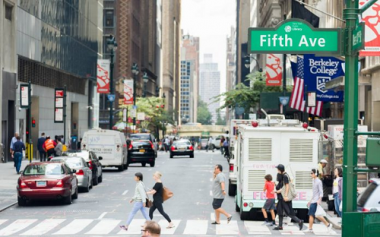Retail rents and the changing face of Fifth Avenue
Rents have been out of sync with retail for some time already on New York’s Fifth Avenue. Two years ago, there were reports of Versace, Ralph Lauren Polo and others preparing to leave the prestigious shopping street. Now that Lord & Taylor has gone too, Henri Bendel is no more and Calvin Klein will leave Madison Avenue, as well as the announcement that the newly opened Neiman Marcus at Hudson Yards will shutter, questions are being asked about the attractivity of midtown New York and the value of the “billboard effect” for retailers as varied as Gap, Nike or Tiffany. Gap, which shut in January, is rethinking its store numbers as part of a larger overhaul; Nike is locked in to its first House of Innovation (see review of latest one in Paris); and Tiffany is attempting to attract younger customers with an updated collection and its Blue Box Café.
The number of vanishing retailers has left a mark on the district: from 49th to 60th street on Fifth Avenue, the availability rate of leases at the end of 2018 hit 27.5%; up from around 5% a decade ago, according to data from real estate firm Cushman & Wakefield. The availability on Madison Avenue last year was 28.2% from 57th to 72nd street. With no traffic, this puts huge pressure on retailers and brands. The price-per-square-foot of retail space between 49th and 60th Street on Fifth Avenue at the end of 2019 was $2668, almost $500 more than a decade ago.
Meanwhile, Nordstrom is attempting to lure customers to the West Side, and some brands have been opening in Westfield and Brookfield Place down at the World Trade Center. Retailers and brands that were born online have been opening stores in SoHo: Everlane, Warby Parker, Allbirds are examples for whom the midtown high rents would make no sense.
Now with the Covid-19, the situation is getting worse with Valentino suing to get out of its lease on Fifth Avenue while Barneys still sits empty. The effect is also being felt on the “magnificent mile” of Michigan Avenue in Chicago, the Strip in Las Vegas, and Rodeo Drive in Los Angeles. Rents have followed but only slowly, and are at their lowest since 2011 across Manhattan. However, they have remained fairly stable at the top end of the rate mentioned above. The number of leases available, on the other hand is increasing steadily.
According to BCG, global luxury sales are forecast to drop around 29% in 2020, amid the decline of tourism. A number of retailers have stopped paying rent to their landlords during the pandemic which in some instances is resulting in litigation (Gap and Simon Property, for example). Most commentators appear optimistic for the long term but in the meantime, the feel of these shopping corridors will be different both through the smaller number of stores and because of the market position of stores moving in, such as Vans, Five Below, or Timberland, for example.
According to Macy’s CEO, tourism to the stores had essentially “disappeared,” with its smaller stores in rural communities recovering faster than its stores in urban shopping meccas. It might be that some of these markets take longer to recover than retail in the suburbs, as many consumers are looking to shop closer to home during the pandemic versus downtown. Researchers at Harvard that have been tracking consumer spending have found also that consumption by high-income households remains far below pre-Covid levels, therefore impacting luxury retailers’ sales.


